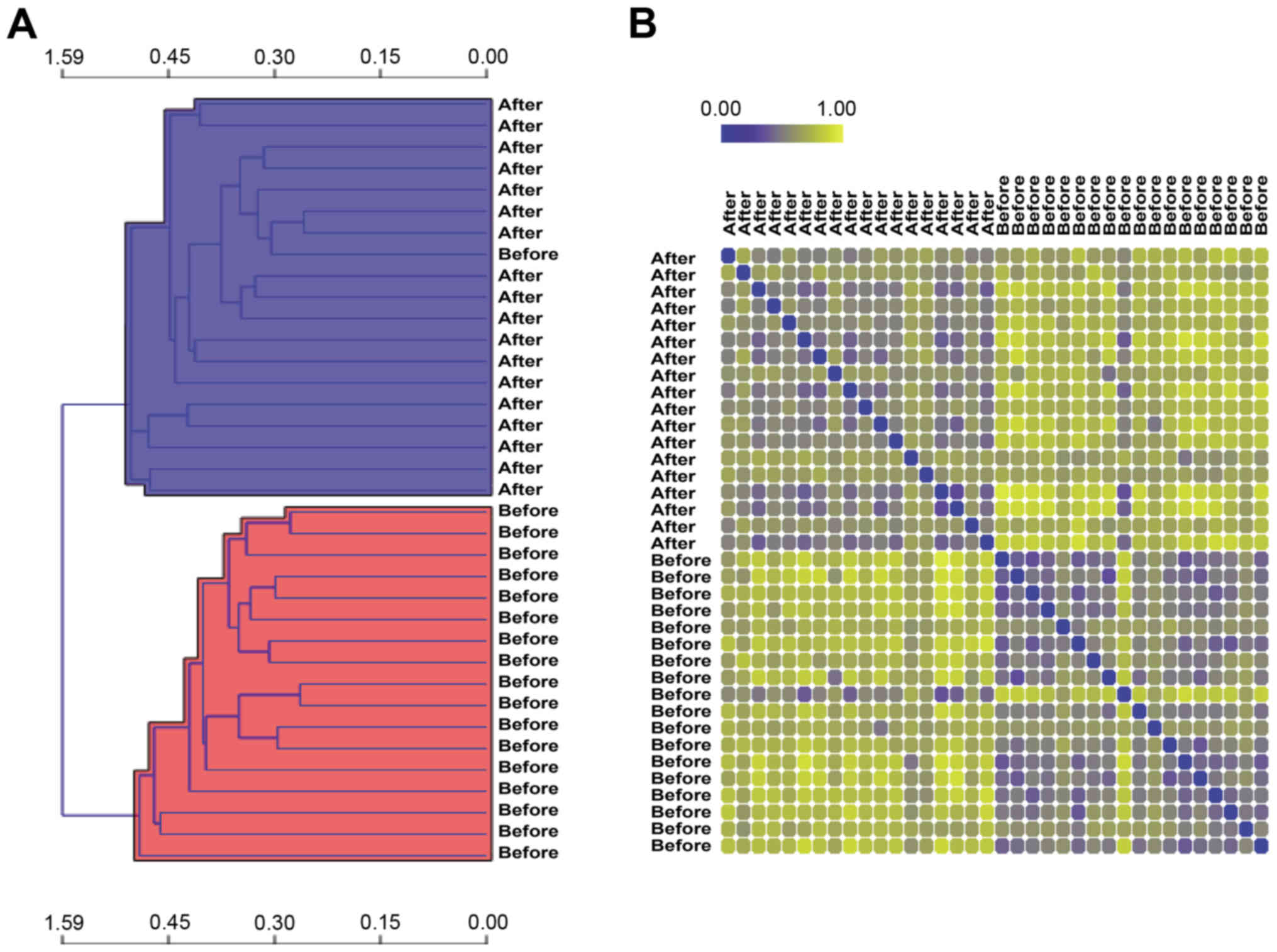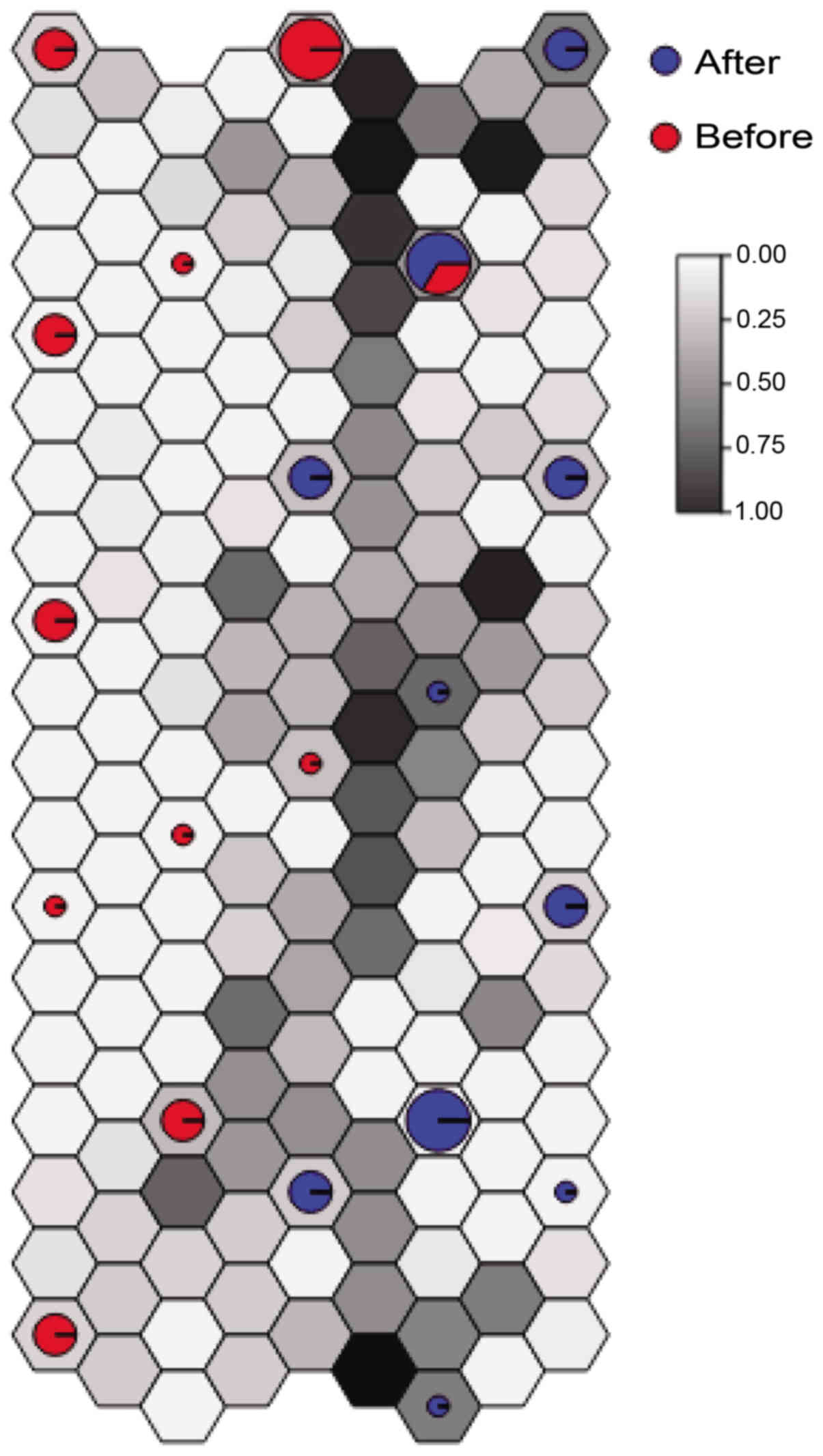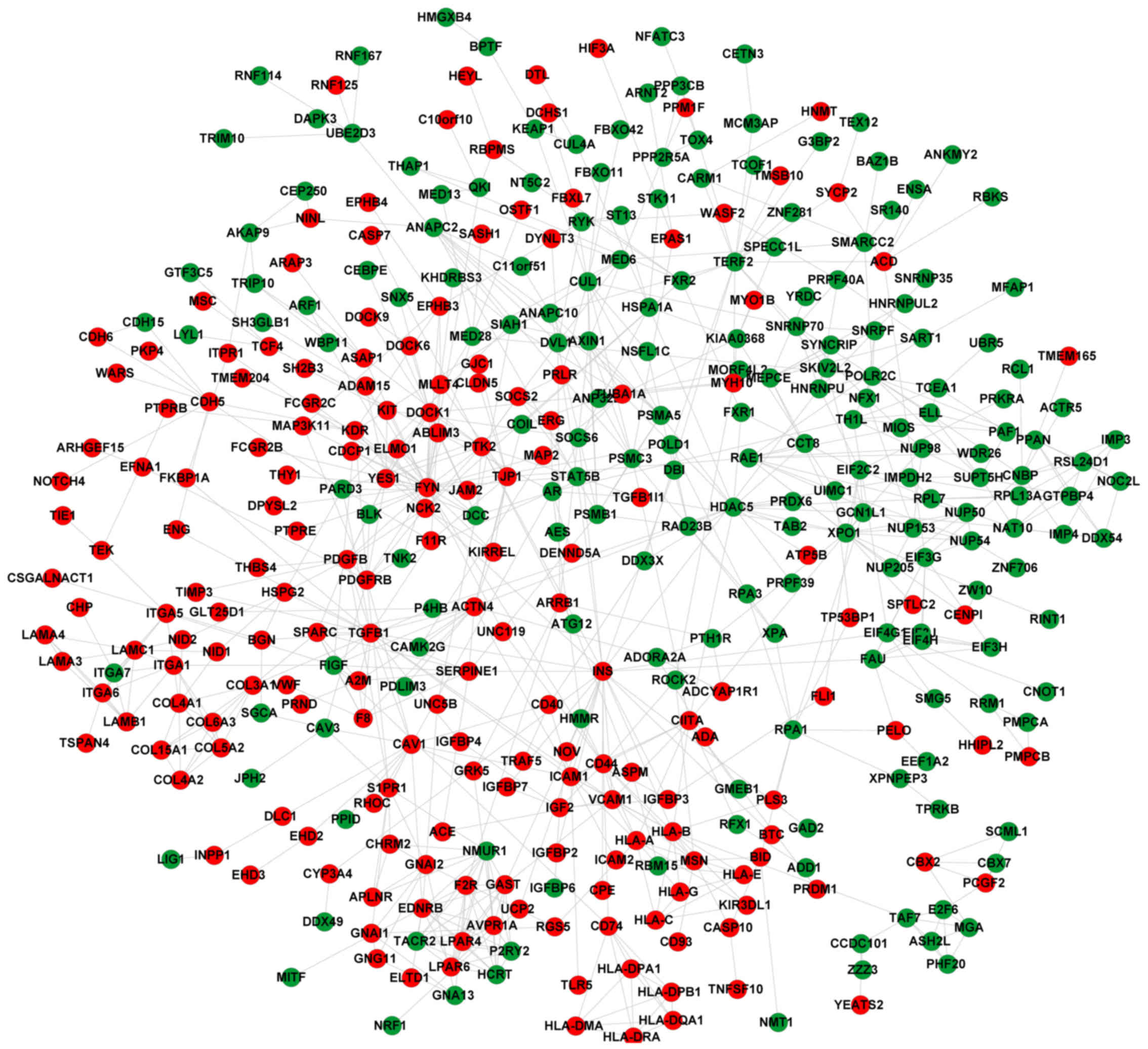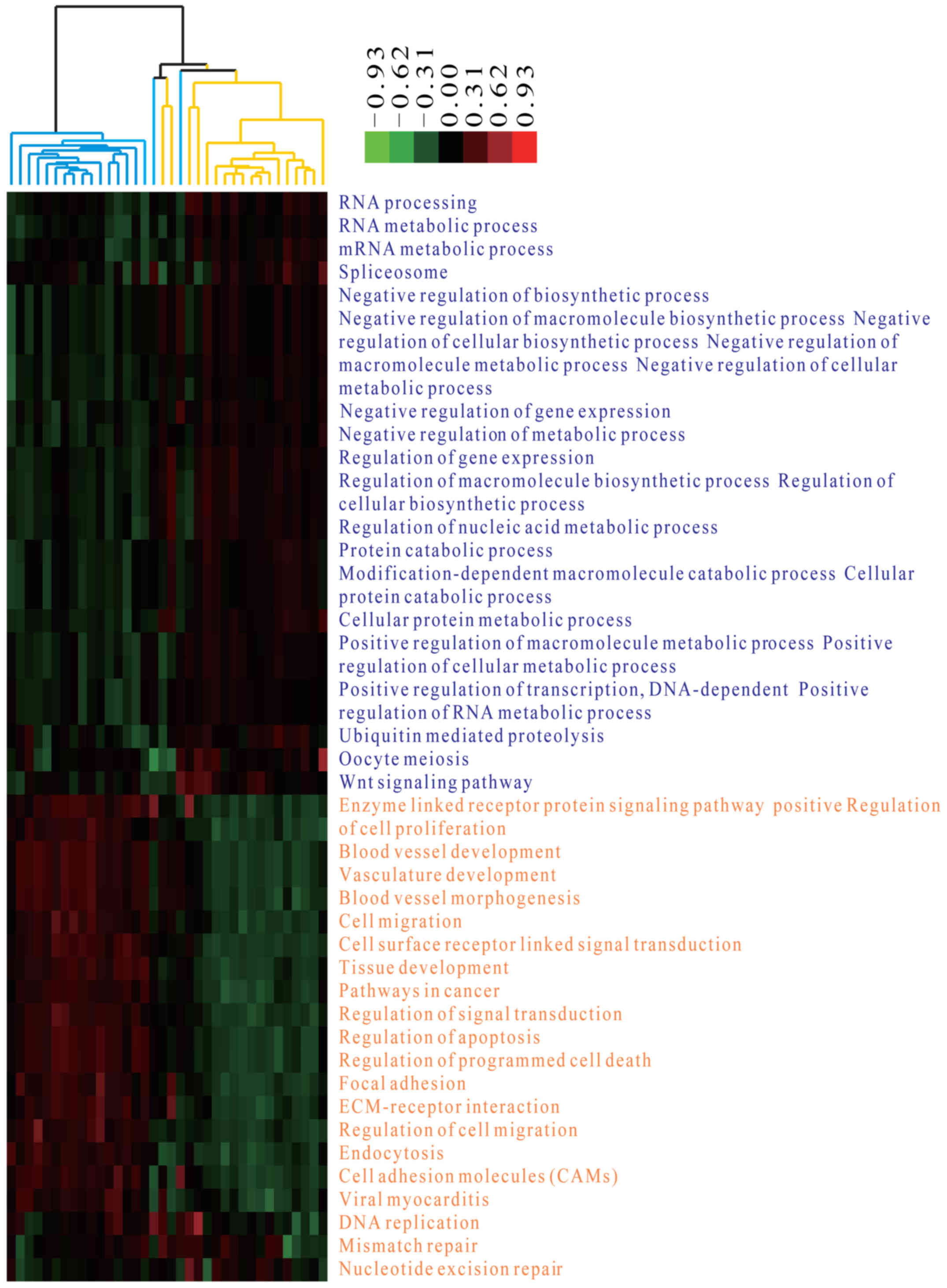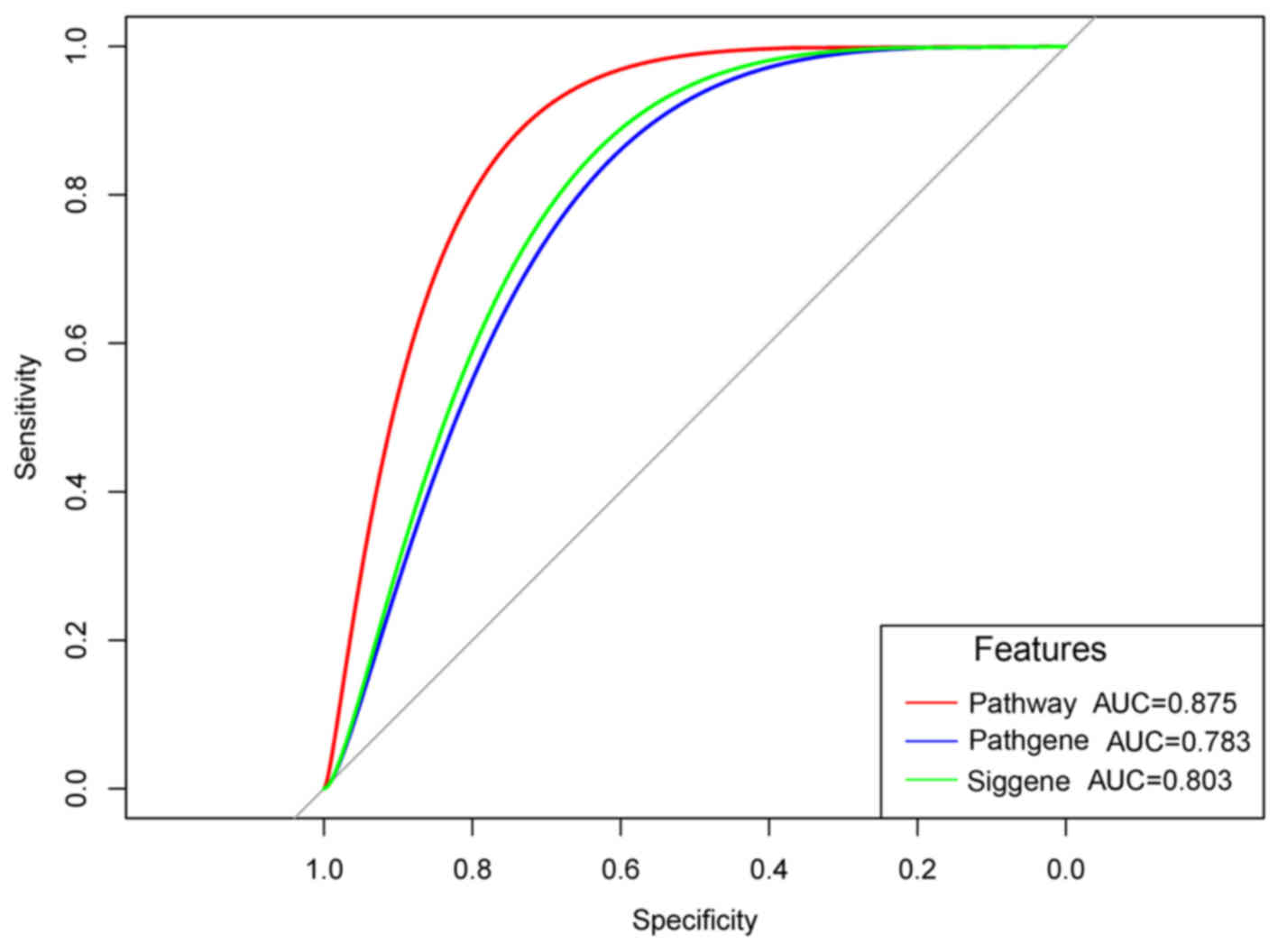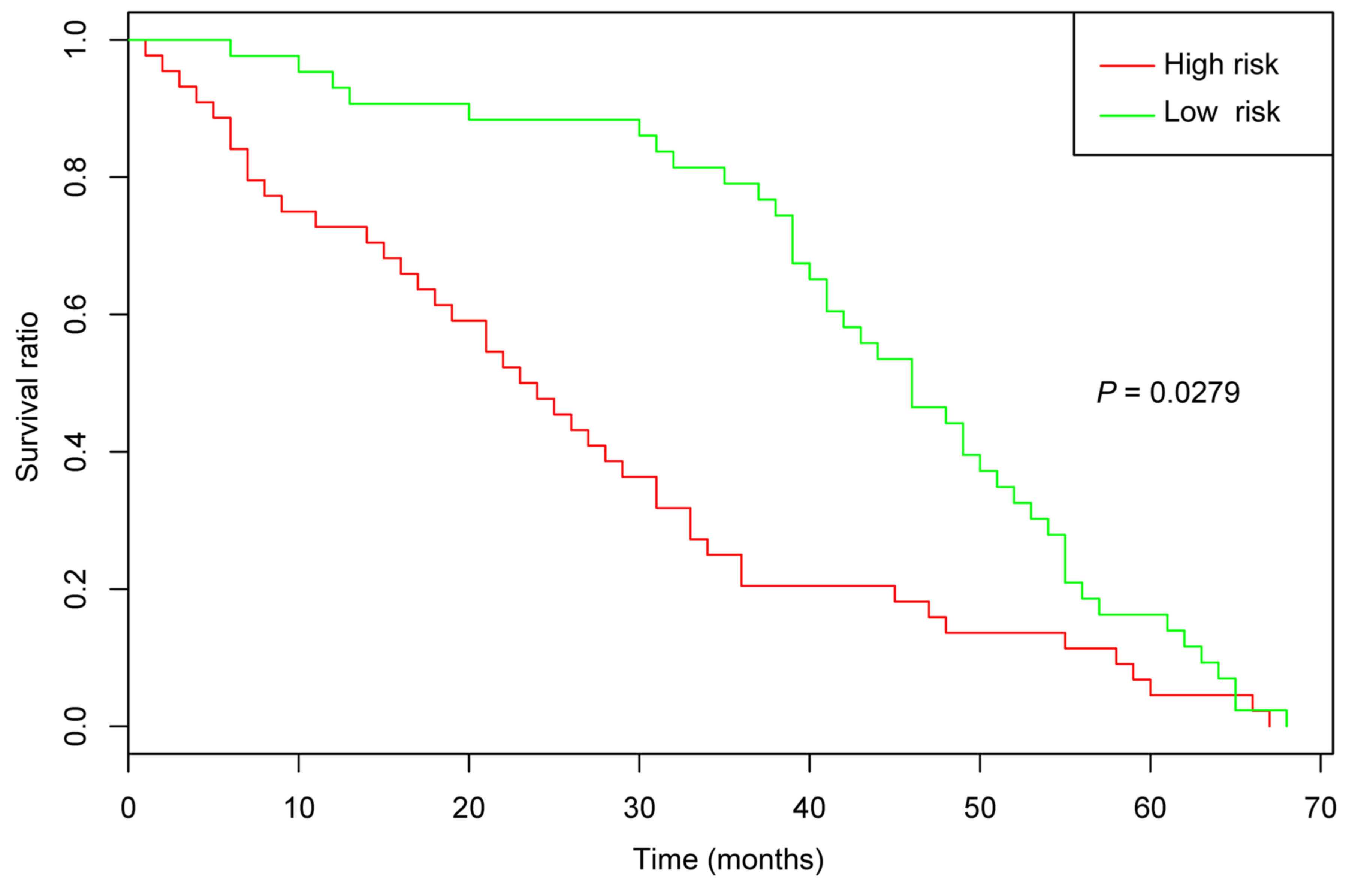| GO:0016070 - RNA
metabolic process | 49 | 1.11E-06 | EIF2C2,
TCOF1, SYNCRIP, SKIV2L2, WTAP,
SART1, SMNDC1, INTS8, IMP3,
RRP1B, ASH2L, TRMT5, QKI,
SUPT5H, IMP4, NFX1, KHDRBS3, AR,
ZCCHC11, PRPF39, MED13, HNRNPU,
C4ORF23, EIF4G1, HNRPDL, CELF1,
SNRPF, MYNN, CPSF3L, ELL, SR140,
WBP11, HSPA1A, POLR2C, PPAN,
RPL7, PRKRA, C19ORF29, GTF3C5,
TCEA1, SNRNP70, SNRNP35, NFATC3,
PRPF40A, SMG5, TAF7, PPP1R8,
POP1, DDX54 |
| GO:0006396 - RNA
processing | 34 | 2.11E-06 | CPSF3L,
EIF2C2, SR140, SYNCRIP, SKIV2L2,
WBP11, WTAP, POLR2C, SART1,
SMNDC1, INTS8, PPAN, IMP3,
RRP1B, RPL7, TRMT5, PRKRA,
C19ORF29, QKI, SNRNP70, SNRNP35,
IMP4, PRPF40A, KHDRBS3, ZCCHC11,
PRPF39, HNRNPU, C4ORF23, HNRPDL,
PPP1R8, POP1, CELF1, DDX54,
SNRPF |
| GO:0010468 -
regulation of gene expression | 97 | 5.20E-04 | EIF2C2,
ARNT2, STAT5B, MORF4L2, NAA15,
SYNCRIP, CNOT1, CBX7, ZNF304,
CRY2, DIRAS3, MED28, SUPT5H,
EIF2B4, MYST3, GTPBP4, MED13,
HNRNPU, BAZ1B, ZNF238, ZNF239,
MNX1, MGA, ZZZ3, CELF1, PAF1,
MYNN, SIVA1, CNBP, ELL, ADORA2A,
HOXA11, TH1L, CYTL1, KEAP1,
NR1H2, LYL1, EIF3H, PRKRA, LHX5,
DNMT3A, TAF7, ZBTB44, UIMC1,
SAFB2, HDAC5, NRF1, EIF4H, ATF7,
SMARCC2, RFX1, DDX54, SOX21,
E2F6, MITF, CTCF, PHF20,
ZKSCAN5, CRX, AES, ASH2L, ACTR5,
CCDC101, ZNF146, QKI, NFX1,
ZNF281, AR, KHDRBS3, ZCCHC11,
GMEB1, ZNF143, HNRPDL, EIF4G1,
MED6, BPTF, CARM1, MTDH, ZBTB11,
SCML1, GCN1L1, MORC3, HMGXB4,
PPP3CB, TCEA1, THAP1, KDM3B,
SNRNP70, NFATC3, TERF2, NACC2,
CEBPE, SIRT4, ZNF669, PKNOX1,
PPP1R8, RBM15 |
| GO:0016071 - mRNA
metabolic process | 21 | 9.32E-04 | EIF2C2,
KHDRBS3, SMG5, SYNCRIP, PRPF39,
WBP11, SKIV2L2, HSPA1A, WTAP,
POLR2C, HNRNPU, SART1, SMNDC1,
PPP1R8, C19ORF29, QKI, CELF1,
SNRNP35, SNRNP70, SNRPF, PRPF40A |
| GO:0010605 -
negative regulation of macromolecule metabolic process | 33 | 1.34E-03 | HCRT,
EIF2C2, MTDH, E2F6, TH1L, CTCF,
ANAPC10, NR1H2, AES, PSMB1,
PRKRA, SUPT5H, TERF2, EIF2B4,
MYST3, NFX1, ZNF281, DNMT3A,
ANAPC2, GTPBP4, NACC2, ZCCHC11,
TAF7, SIRT4, UIMC1, HDAC5,
ZNF238, BPTF, PSMA5, PSMC3,
SMARCC2, CELF1, RBM15 |
| GO:0030163 -
protein catabolic process | 29 | 1.68E-03 | RAD23B,
KIAA0368, ATG12, UBE3B, UBE2V2,
ANAPC10, UBE2D3, LONP1, USP27X,
PSMB1, OTUD7B, RNF167, FBXO42,
FBXO9, TPRKB, CUL1, NFX1, AXIN1,
ANAPC2, SOCS6, SOCS5, KCMF1,
CUL4A, PSMC3, PSMA5, UBR5,
SIAH1, PCYOX1, FBXO11 |
| GO:0043632 -
modification-dependent macromolecule catabolic process | 27 | 2.20E-03 | RAD23B,
ATG12, UBE3B, KIAA0368, UBE2V2,
ANAPC10, LONP1, USP27X, UBE2D3,
PSMB1, OTUD7B, RNF167, FBXO42,
FBXO9, CUL1, NFX1, ANAPC2,
SOCS6, SOCS5, KCMF1, CUL4A,
PSMC3, PSMA5, UBR5, SIAH1,
PCYOX1, FBXO11 |
| GO:0010629 -
negative regulation of gene expression | 24 | 3.64E-03 | ZNF281,
DNMT3A, EIF2C2, NACC2, ZCCHC11,
MTDH, E2F6, TH1L, TAF7, SIRT4,
CTCF, UIMC1, NR1H2, HDAC5, AES,
ZNF238, BPTF, PRKRA, SMARCC2,
CELF1, SUPT5H, RBM15, MYST3,
NFX1 |
| GO:0019219 -
regulation of nucleic acid metabolic process | 91 | 4.03E-03 | EIF2C2,
SOX21, E2F6, MORF4L2, MITF,
STAT5B, ARNT2, NAA15, SYNCRIP,
CNOT1, CTCF, PHF20, CBX7,
ZKSCAN5, CRX, ZNF304, CRY2, AES,
ASH2L, MED28, ACTR5, CCDC101,
ZNF146, SUPT5H, MYST3, NFX1,
ZNF281, AR, KHDRBS3, GTPBP4,
GMEB1, ZNF143, MED13, HNRNPU,
MED6, HNRPDL, ZNF238, BPTF,
BAZ1B, ZNF239, MNX1, MGA, ZZZ3,
PAF1, CARM1, MYNN, SIVA1, HCRT,
CNBP, MTDH, ADORA2A, ELL,
ZBTB11, HOXA11, SCML1, PTH1R,
TH1L, CYTL1, UBE2V2, KEAP1,
NR1H2, LYL1, HMGXB4, LHX5,
THAP1, TCEA1, KDM3B, SNRNP70,
NFATC3, TERF2, GUCA1B, DNMT3A,
GUCA1A, NACC2, CEBPE, TAF7,
SIRT4, ZNF669, ZBTB44, UIMC1,
SAFB2, HDAC5, NRF1, P2RY11,
PKNOX1, PPP1R8, ATF7, SMARCC2,
RFX1, DDX54, RBM15 |
| GO:0044257 -
cellular protein catabolic process | 27 | 4.27E-03 | RAD23B,
ATG12, UBE3B, KIAA0368, UBE2V2,
ANAPC10, LONP1, USP27X, UBE2D3,
PSMB1, OTUD7B, RNF167, FBXO42,
FBXO9, CUL1, NFX1, ANAPC2,
SOCS6, SOCS5, KCMF1, CUL4A,
PSMC3, PSMA5, UBR5, SIAH1,
PCYOX1, FBXO11 |
| GO:0010558 -
negative regulation of macromolecule biosynthetic process | 25 | 4.95E-03 | HCRT,
EIF2C2, MTDH, E2F6, TH1L, CTCF,
NR1H2, AES, SUPT5H, EIF2B4,
TERF2, NFX1, MYST3, ZNF281,
DNMT3A, GTPBP4, NACC2, TAF7,
SIRT4, UIMC1, HDAC5, ZNF238,
BPTF, SMARCC2, RBM15 |
| GO:0031325 -
positive regulation of cellular metabolic process | 35 | 6.60E-03 | CNBP,
ADORA2A, MORF4L2, ARNT2, MITF,
STAT5B, NAA15, CYTL1, CTCF,
ANAPC10, CRX, NR1H2, PSMB1,
TCEA1, CD24, SUPT5H, NFATC3,
TERF2, CUL1, MYST3, AXIN1,
ANAPC2, AR, TAF7, MED13, UIMC1,
MED6, HDAC5, PKNOX1, BPTF,
PSMA5, PSMC3, SMARCC2, TNK2,
RBM15 |
| GO:0031327 -
negative regulation of cellular biosynthetic process | 25 | 6.64E-03 | HCRT,
EIF2C2, MTDH, E2F6, TH1L, CTCF,
NR1H2, AES, SUPT5H, EIF2B4,
TERF2, NFX1, MYST3, ZNF281,
DNMT3A, GTPBP4, NACC2, TAF7,
SIRT4, UIMC1, HDAC5, ZNF238,
BPTF, SMARCC2, RBM15 |
| GO:0031324 -
negative regulation of cellular metabolic process | 30 | 6.85E-03 | HCRT,
EIF2C2, MTDH, E2F6, TH1L, CTCF,
ANAPC10, NR1H2, AES, PSMB1, SUPT5H,
EIF2B4, TERF2, MYST3, NFX1,
ZNF281, DNMT3A, ANAPC2, GTPBP4,
NACC2, TAF7, SIRT4, UIMC1,
HDAC5, ZNF238, BPTF, PSMC3,
PSMA5, SMARCC2, RBM15 |
| GO:0044267 -
cellular protein metabolic process | 77 | 7.19E-03 | EIF2C2,
KIAA0368, NAA15, ART3, USP27X,
LONP1, CRY2, FAU, SIK2, EIF2B4,
CUL1, MYST3, NFX1, ANAPC2, SGK2,
ROCK2, SECISBP2, SOCS6, SOCS5,
DAPK3, ST13, EIF4G1, BAZ1B,
PSMA5, UBR5, SIAH1, PAF1,
PCYOX1, CARM1, TM4SF4, FBXO11,
RAD23B, UBE3B, ATG12, STK11,
BLK, CAMK2G, MAPKAPK5, ANAPC10,
UBE2V2, AKAP9, MTMR3, UBE2D3,
EIF3G, RPL7, PSMB1, MORC3,
EIF3H, SH3GLB1, PRKRA, OTUD7B,
PPP3CB, RNF167, FBXO42, RSL24D1,
EIF3J, FBXO9, OBSCN, P4HB,
ALPK3, RYK, EEF1A2, SIRT4,
OXSR1, LOC653566, UIMC1, HDAC5,
NMT1, CUL4A, KCMF1, RPL13A,
PSMC3, PPID, EIF4H, CCT8, LGTN,
TNK2 |
| GO:0031326 -
regulation of cellular biosynthetic process | 93 | 7.26E-03 | EIF2C2,
SOX21, E2F6, MORF4L2, STAT5B,
ARNT2, MITF, NAA15, CNOT1, CTCF,
PHF20, CBX7, ZKSCAN5, CRX,
ZNF304, CRY2, AES, ASH2L, MED28,
ACTR5, CCDC101, ZNF146, QKI,
SUPT5H, EIF2B4, MYST3, NFX1,
ZNF281, AR, KHDRBS3, GTPBP4,
GMEB1, ZNF143, MED13, MED6,
HNRPDL, EIF4G1, ZNF238, BPTF,
BAZ1B, ZNF239, MNX1, MGA, ZZZ3,
PAF1, CARM1, MYNN, SIVA1, HCRT,
CNBP, MTDH, ADORA2A, ELL,
ZBTB11, HOXA11, SCML1, PTH1R,
TH1L, CYTL1, KEAP1, GCN1L1,
NR1H2, EIF3H, LYL1, HMGXB4,
LHX5, THAP1, TCEA1, KDM3B,
NFATC3, TERF2, GUCA1B, DNMT3A,
GUCA1A, NACC2, CEBPE, TAF7,
SIRT4, ZNF669, ZBTB44, UIMC1,
SAFB2, HDAC5, NRF1, P2RY11,
PKNOX1, PPP1R8, EIF4H, ATF7,
SMARCC2, RFX1, DDX54, RBM15 |
| GO:0010604 -
positive regulation of macromolecule metabolic process | 34 | 7.79E-03 | CNBP,
MORF4L2, ARNT2, MITF, STAT5B,
NAA15, CYTL1, CTCF, ANAPC10,
CRX, NR1H2, PSMB1, TCEA1, CD24,
SUPT5H, NFATC3, TERF2, CUL1,
MYST3, AXIN1, ANAPC2, AR, TAF7,
MED13, UIMC1, MED6, HDAC5,
PKNOX1, BPTF, PSMA5, PSMC3,
SMARCC2, TNK2, RBM15 |
| GO:0045893 -
positive regulation of transcription, DNA-dependent | 22 | 7.98E-03 | AR,
CNBP, MORF4L2, ARNT2, STAT5B,
MITF, TAF7, CYTL1, NAA15, CTCF,
MED13, CRX, NR1H2, MED6, HDAC5,
PKNOX1, BPTF, SMARCC2, TCEA1,
SUPT5H, NFATC3, RBM15 |
| GO:0009890 -
negative regulation of biosynthetic process | 25 | 8.53E-03 | HCRT,
EIF2C2, MTDH, E2F6, TH1L, CTCF,
NR1H2, AES, SUPT5H, EIF2B4,
TERF2, NFX1, MYST3, ZNF281,
DNMT3A, GTPBP4, NACC2, TAF7,
SIRT4, UIMC1, HDAC5, ZNF238,
BPTF, SMARCC2, RBM15 |
| GO:0051254 -
positive regulation of RNA metabolic process | 22 | 8.70E-03 | AR,
CNBP, MORF4L2, ARNT2, STAT5B,
MITF, TAF7, CYTL1, NAA15, CTCF,
MED13, CRX, NR1H2, MED6, HDAC5,
PKNOX1, BPTF, SMARCC2, TCEA1,
SUPT5H, NFATC3, RBM15 |
| GO:0045934 -
negative regulation of nucleic acid metabolic process | 23 | 8.74E-03 | ZNF281,
DNMT3A, HCRT, GTPBP4, NACC2,
MTDH, E2F6, TH1L, TAF7, SIRT4,
CTCF, UIMC1, NR1H2, HDAC5, AES,
ZNF238, BPTF, SMARCC2, SUPT5H,
RBM15, TERF2, MYST3, NFX1 |
| GO:0010556 -
regulation of macromolecule biosynthetic process | 89 | 9.86E-03 | EIF2C2,
SOX21, E2F6, MORF4L2, STAT5B,
ARNT2, MITF, NAA15, CNOT1, CTCF,
PHF20, CBX7, ZKSCAN5, CRX,
ZNF304, CRY2, AES, ASH2L, MED28,
ACTR5, CCDC101, ZNF146, QKI,
SUPT5H, EIF2B4, MYST3, NFX1,
ZNF281, AR, KHDRBS3, GTPBP4,
GMEB1, ZNF143, MED13, MED6,
HNRPDL, EIF4G1, ZNF238, BPTF,
BAZ1B, ZNF239, MNX1, MGA, ZZZ3,
PAF1, CARM1, MYNN, SIVA1, HCRT,
CNBP, MTDH, ADORA2A, ELL,
ZBTB11, HOXA11, SCML1, TH1L,
CYTL1, KEAP1, GCN1L1, NR1H2,
EIF3H, LYL1, HMGXB4, LHX5,
THAP1, TCEA1, KDM3B, NFATC3,
TERF2, DNMT3A, NACC2, CEBPE,
TAF7, SIRT4, ZNF669, ZBTB44,
UIMC1, SAFB2, HDAC5, NRF1,
PKNOX1, PPP1R8, EIF4H, ATF7,
SMARCC2, RFX1, DDX54, RBM15 |















